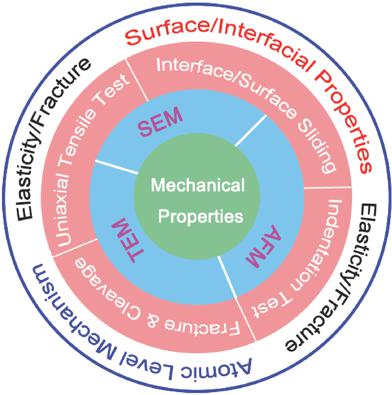当前位置:
X-MOL 学术
›
Adv. Mater. Interfaces
›
论文详情
Our official English website, www.x-mol.net, welcomes your feedback! (Note: you will need to create a separate account there.)
Mechanical Properties of 2D Materials Studied by In Situ Microscopy Techniques
Advanced Materials Interfaces ( IF 5.4 ) Pub Date : 2018-01-02 , DOI: 10.1002/admi.201701246 Xing Li 1 , Mei Sun 2 , Chongxin Shan 1 , Qing Chen 2 , Xianlong Wei 2
Advanced Materials Interfaces ( IF 5.4 ) Pub Date : 2018-01-02 , DOI: 10.1002/admi.201701246 Xing Li 1 , Mei Sun 2 , Chongxin Shan 1 , Qing Chen 2 , Xianlong Wei 2
Affiliation

|
Two‐dimensional (2D) materials have been demonstrated as promising building blocks in future electronic and their mechanical properties are quite important for various applications. Due to their atomic thickness and planar nature, the investigation of the mechanical properties and related atomic mechanism are quite challenging. This review focuses on the recently developed in situ techniques based on scanning electron microscopy (SEM), transmission electron microscopy (TEM), and atomic force microscopy (AFM) in characterization of the mechanical properties of 2D materials. In situ methods used for studying their elastic properties, fracture behavior, and surface/interface energy are introduced in detail. Specifically, the AFM indentation test and microelectromechanical systems (MEMS) device are generally used to investigate the elastic properties; the manipulator based methods show their flexibility in studying the fracture, adhesion, cleavage, and friction properties; atomic level fracture mechanism can be revealed with in situ high resolution TEM (HRTEM); the pressurized blister test and the buckle/wrinkle based methods are widely used to measure the surface/interface properties. Moreover, the influence of sample preparation process, defects and layer numbers to their mechanical properties are also discussed. Finally, the extensions of above methods to investigate the strain‐modulated physical properties of 2D materials are introduced.
中文翻译:

原位显微技术研究二维材料的力学性能
二维(2D)材料已被证明是未来电子产品中很有希望的组成部分,其机械性能对于各种应用而言非常重要。由于它们的原子厚度和平面性质,对机械性能和相关原子机理的研究非常具有挑战性。这篇综述集中于基于二维电子材料的机械性能表征的基于扫描电子显微镜(SEM),透射电子显微镜(TEM)和原子力显微镜(AFM)的最新开发的原位技术。详细介绍了用于研究其弹性性能,断裂行为和表面/界面能的原位方法。具体而言,通常使用AFM压痕测试和微机电系统(MEMS)装置来研究其弹性性能。基于机械手的方法在研究断裂,粘附,劈裂和摩擦性能方面显示出了灵活性。原位高分辨率TEM(HRTEM)可以揭示原子级断裂机理。加压起泡测试和基于折皱/起皱的方法被广泛用于测量表面/界面特性。此外,还讨论了样品制备过程,缺陷和层数对其力学性能的影响。最后,介绍了上述方法的扩展,以研究二维材料的应变调制物理特性。加压起泡测试和基于折皱/起皱的方法被广泛用于测量表面/界面特性。此外,还讨论了样品制备过程,缺陷和层数对其力学性能的影响。最后,介绍了上述方法的扩展,以研究二维材料的应变调制物理特性。加压起泡测试和基于折皱/起皱的方法被广泛用于测量表面/界面特性。此外,还讨论了样品制备过程,缺陷和层数对其力学性能的影响。最后,介绍了上述方法的扩展,以研究二维材料的应变调制物理特性。
更新日期:2018-01-02
中文翻译:

原位显微技术研究二维材料的力学性能
二维(2D)材料已被证明是未来电子产品中很有希望的组成部分,其机械性能对于各种应用而言非常重要。由于它们的原子厚度和平面性质,对机械性能和相关原子机理的研究非常具有挑战性。这篇综述集中于基于二维电子材料的机械性能表征的基于扫描电子显微镜(SEM),透射电子显微镜(TEM)和原子力显微镜(AFM)的最新开发的原位技术。详细介绍了用于研究其弹性性能,断裂行为和表面/界面能的原位方法。具体而言,通常使用AFM压痕测试和微机电系统(MEMS)装置来研究其弹性性能。基于机械手的方法在研究断裂,粘附,劈裂和摩擦性能方面显示出了灵活性。原位高分辨率TEM(HRTEM)可以揭示原子级断裂机理。加压起泡测试和基于折皱/起皱的方法被广泛用于测量表面/界面特性。此外,还讨论了样品制备过程,缺陷和层数对其力学性能的影响。最后,介绍了上述方法的扩展,以研究二维材料的应变调制物理特性。加压起泡测试和基于折皱/起皱的方法被广泛用于测量表面/界面特性。此外,还讨论了样品制备过程,缺陷和层数对其力学性能的影响。最后,介绍了上述方法的扩展,以研究二维材料的应变调制物理特性。加压起泡测试和基于折皱/起皱的方法被广泛用于测量表面/界面特性。此外,还讨论了样品制备过程,缺陷和层数对其力学性能的影响。最后,介绍了上述方法的扩展,以研究二维材料的应变调制物理特性。



























 京公网安备 11010802027423号
京公网安备 11010802027423号